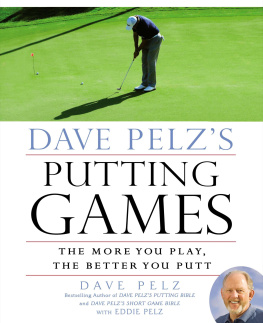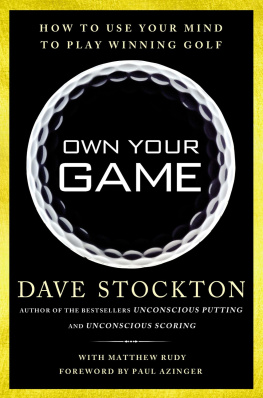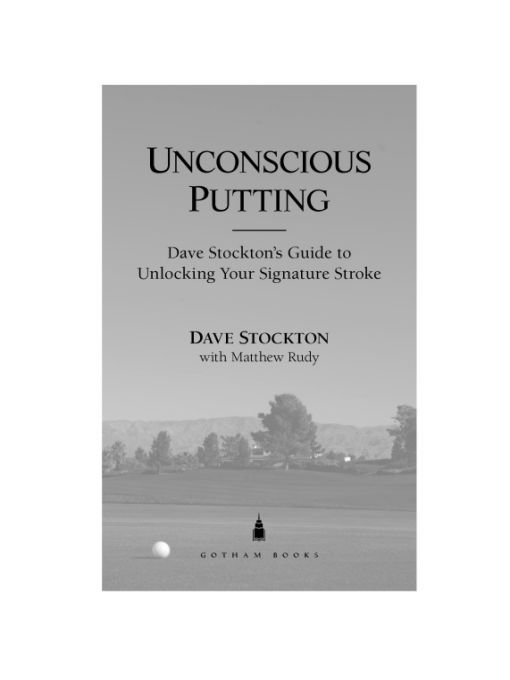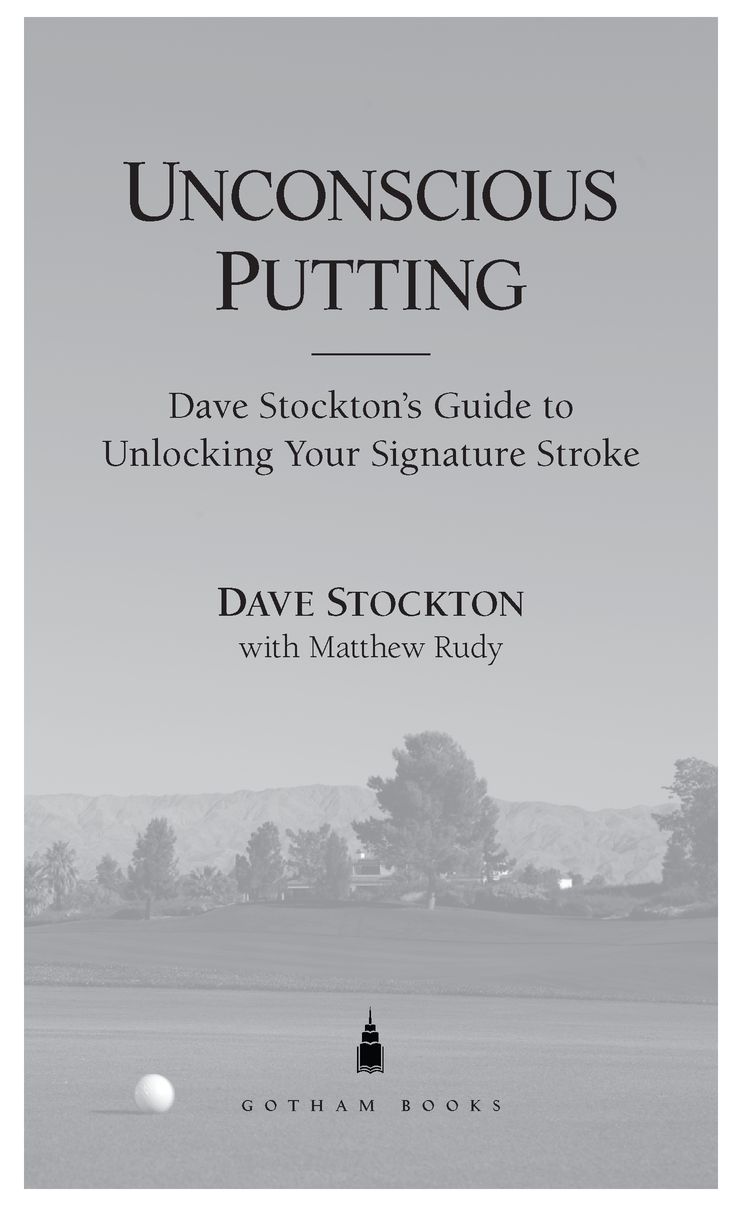Table of Contents
FOREWORD
by Phil Mickelson
For a number of years, I had been putting very sporadically, and I really didnt have any direction. I didnt know what I was trying to do with my putting. I was getting frustrated, so asked my caddie, Bones Mackay, who I should go see, and he recommended Dave Stockton.
I had obviously heard good things about the work Dave had been doing with other players, but I was looking forward to hearing his assessment of my putting game. We met in San Diego in September 2009, at The Bridges, and spent two days having breakfast and then putting for a couple of hours. I knew this was going to be a good fit immediately. Hes so positive and so much fun to be around, and I had instant respect for himthe career he has had and the major championships hes won give him a lot of credibility.
As we started working, I knew it was going to end up going well, because he made putting simple for me again. With Dave, putting started to feel like it did when I was a kid. As a professional, I had started to overcomplicate things, and knowing the importance of making putts, I got caught up in results. I started focusing too much on mechanics and technique, and I stopped seeing the line as well.
Dave simplified all that, quickly.
I started to look at the hole and the line of the putt longer, and by taking the back of my hand and making it the putterface, I dont even need to look at the alignment of the putter anymore. Im just taking the back of my hand at the hole, which really simplifies the process. I feel like Im putting with directionwhether I have a good putting day or not. I feel like Im getting back into the feel of the putttrying to make a good rolland not getting caught up in the mechanics. Im seeing the line again, and Im feeling really good over the ball.
After those couple of days with Dave, it didnt take long to start seeing more putts go in. I had 36 one-putts at the Tour Championship the next week. Up to that point in the 2009 season, I had made thirteen putts of more than 20 feet all year. At East Lake, I made nine in four rounds and won the tournament. When you can focus on a simple, concise routine and youre seeing the line well, the confidence that follows is extremely valuableespecially at a place like Augusta National.
Im grateful for Daves help, and Im sure youll enjoy putting a lot more after you hear what he has to say.
Phil Mickelson
May 6, 2011
PREFACE
By Dave Stockton Jr. and Ron Stockton
The lessons, strategies, and philosophies youre going to read about here in Unconscious Putting are special ones to us. Weve been sharing them week in and week out in clinics full of 20-handicappers and in consultation with the best players in the world on every major professional tour.
But its more than that.
The ideas in this book are the same ones we grew up with. As kids, we learned to see the line and follow a routine listening to Dadand to our grandfather, Gailand that teaching style never changed. Hes always talked about feel, and the importance of using your imagination to create a shot in your mind before you hit it. The ideas are simple, and theyve been tested and perfected through more than seventy years of competition, from our grandfathers time learning from Alex Morrison and playing with greats like Walter Hagen to Dads time on the PGA and Champions tours, to our experience of playing on teaching on the professional tours.
Theyre part of our family tradition.
That family element is also what has made the last couple of years so satisfying. Working together in the family business has been fantastic, and were looking forward to helping a lot more people in the years to come. We all have our strong opinions, but when it comes to instruction, were all in agreement. And the players weve helpedfrom 90-shooters in a clinic in Colorado to a multiple major-championship winner like Phil Mickelsonhave gotten the benefit of that insight and experience.
Weve heard some people say you cant reach everyone. That some teaching philosophies just dont work for some players. In the decades of teaching and playing experience we have as a group, we dont think thats true. Weve all worked with players who came away from a lesson feeling like they didnt get what they were looking for.
But thats almost always because of the dominant culture in golf instruction these daysthe cult of mechanics. A lot of players think that if they arent overhauling the way they hold it or the way they stroke it, they arent going to get better. You can even see the disappointment flicker on their faces when we tell them theres no golden mechanical piece to the stroke that will solve every problem.
Our hope is to show all the players we teach in a lesson, clinicor through this bookthat it is simple, but that it doesnt come from mechanics. The mind controls what you do on the putting green. Stay open to that fact and learn to embrace your own personal putting signature and how to see the line and you can dramatically improve how you roll your ballwith the stroke you have. Even the tour players we teach will often finish a first lesson making a bunch more putts and tell us that it has to be tougher than this. That putting cant be that easy. Its so satisfying to spend some time with a player like Martin Lairdwho was ranked near the bottom in the tour putting statsand see him gain confidence almost immediately and pour a putt right in the heart to win a huge tournament like Bay Hill. And Martin was just one of more than two dozen tour playersJustin Rose, Yani Tseng, Morgan Pressel, Adam Scott, Michelle Wie, Massy Kuramoto, Matt Kuchar, Sean OHair, Suzann Pettersen, and J. B. Holmes are some otherswho understood the value of better putting and dramatically improved after coming for help.
Weve seen it over and over again, in just a thirty- or forty-five-minute lesson. Read the book and give it a chance, and youll see it for yourself.
INTRODUCTION
How much of this game is mental?
If you walk the golf instruction aisle at the bookstore, subscribe to one of the popular golf magazines, or listen to some instructors teach, you could get the idea that how you hold the club or how well you copy a series of positions determines whether or not you can play golf. The mental side might get some attention here or there, but its seen as a kind of accessory to the real meat and potatoesswing mechanics.
To me, thats backward.
Are mechanics a part of the game? Absolutely. You make the physical job of hitting a shot easier the closer you get to standard when it comes to setup and the swing. But putting is a completely different animal. Even on the longest putt, the putterhead moves a couple of feet at most. Success is determined by how well you sort out the speed and break of your putt and translate that read into the roll of the ball. By how well you use your headand then get out of your own way emotionally.
Putting is an art. But a vast majority of teachers treat it almost the same way they do the full swingwith a series of diagrams and technical advice about the shape of the stroke and the percentage of weight that should be distributed on each foot, or with some kind of training aid.
In Unconscious Putting, Im going to introduce you to an easier, more instinctive way to putt. Instead of being locked up thinking about your stroke or trying to copy positions, youll be locked inon the line and on rolling your ball.









